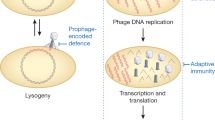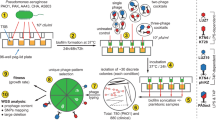Abstract
Following a sixty-year hiatus in western medicine, bacteriophages (phages) are again being advocated for treating and preventing bacterial infections. Are attempts to use phages for clinical and environmental applications more likely to succeed now than in the past? Will phage therapy and prophylaxis suffer the same fates as antibiotics — treatment failure due to acquired resistance and ever-increasing frequencies of resistant pathogens? Here, the population and evolutionary dynamics of bacterial–phage interactions that are relevant to phage therapy and prophylaxis are reviewed and illustrated with computer simulations.
This is a preview of subscription content, access via your institution
Access options
Subscribe to this journal
Receive 12 print issues and online access
$209.00 per year
only $17.42 per issue
Buy this article
- Purchase on Springer Link
- Instant access to full article PDF
Prices may be subject to local taxes which are calculated during checkout
Similar content being viewed by others
References
Radetsky, P. The good virus. Discover 17, 52 (1996).
Alisky, J., Iczkowski, K., Rapoport, A. & Troitsky, N. Bacteriophages show promise as antimicrobial agents. J. Infect. 36, 5–15 (1998).
Kutter, E. [online], (cited 3 Dec 2003), <http://www.evergreen.edu/phage/phagetherapy/phagetherapy.html> (2000).
Summers, W. C. Bacteriophage therapy. Annu. Rev. Microbiol. 55, 437–451 (2001).
Sulakvelidze, A. & Morris, J. G. Jr. Bacteriophages as therapeutic agents. Ann. Med. 33, 507–509 (2001).
Sulakvelidze, A., Alavidze, Z. & Morris, J. G. Jr. Bacteriophage therapy. Antimicrob. Agents Chemother. 45, 649–659 (2001).
Merril, C. R., Scholl, D. & Adhya, S. L. The prospect for bacteriophage therapy in western medicine. Nature Rev. Drug Discov. 2, 489–497 (2003).
Finland, M. Adventures with antibacterial drugs. Clin. Pharmacol. Ther. 13, 469–511 (1972).
Keller, M. A. & Stiehm, E. R. Passive immunity in prevention and treatment of infectious diseases. Clin. Microbiol. Rev. 13, 602–614 (2000).
Smith, H. W. & Hugggins, M. B. Successful treatment of experimental Escherichia coli infections in mice using phage: its general superiority over antibiotics. J. Gen. Microbiol. 128, 307–318 (1982).
Smith, H. W. & Huggin, M. B. Effectiveness of phages in treating experimental Escherichia coli diarrhoea in calves, piglets and lambs. J. Gen. Microbiol. 129, 2659–2675 (1983).
Smith, H. W., Huggins, M. B. & Shaw, K. M. The control of experimental Escherichia coli diarrhoea in calves by means of bacteriophage. J. Gen. Microbiol. 133, 1111–1126 (1987).
Soothill, J. S. Treatment of experimental infections of mice with bacteriophage. J. Med. Microbiol. 37, 258–262 (1992).
Soothill, J. S. Bacteriophage prevents destruction of skin grafts by Pseudomonas aeruginosa. Burns 20, 209–11 (1994).
Merril, C. R. et al. Long-circulating bacteriophage as antibacterial agents. Proc. Natl Acad. Sci. USA 93, 3188–3192 (1996).
Matsuzaki, S. et al. Experimental protection of mice against lethal Staphylococcus aureus infection by novel bacteriophage φ MR11. J. Infect. Dis. 187, 613–624 (2003).
Biswas, B. et al. Bacteriophage therapy rescues mice bacteremic from a clinical isolate of vancomycin-resistant Enterococcus faecium. Infect. Immun. 70, 204–210 (2002).
Park, S. C. & Nakai, T. Bacteriophage control of Pseudomonas plecoglossicida infection in ayu Plecoglossus altivelis. Dis Aquat Organ 53, 33–9 (2003).
Weld, R. J. & A. J. Heinemann, J. Journal of Theoretical Biology (in the press).
Levin, B. R. & Bull, J. J. Phage therapy revisited: the population biology of a bacterial infection and its treatment with bacteria and antibiotics. Am. Nat. 147, 881–898 (1996).
Payne, R. J. & Jansen, V. A. Phage therapy: the peculiar kinetics of self-replicating pharmaceuticals. Clin. Pharmacol. Ther. 68, 225–230 (2000).
Payne, R. J. & Jansen, V. A. Understanding bacteriophage therapy as a density-dependent kinetic process. J. Theor. Biol. 208, 37–48 (2001).
Payne, R. J. & Jansen, V. A. Pharmacokinetic principles of bacteriophage therapy. Clin. Pharmacokinet. 42, 315–325 (2003).
Kasman, L. M. et al. Overcoming the phage replication threshold: a mathematical model with implications for phage therapy. J. Virol. 76, 5557–5564 (2002).
Adams, M. H. Bacteriophages (Wiley, New York, 1959).
Stent, G. S. Molecular Biology of Bacterial Viruses (Freeman, San Francisco, 1963).
Campbell, A. The future of bacteriophage biology. Nature Rev. Genet. 4, 471–477 (2003).
Westwater, C. et al. Use of genetically engineered phage to deliver antimicrobial agents to bacteria: an alternative therapy for treatment of bacterial infections. Antimicrob. Agents Chemother. 47, 1301–1307 (2003).
Leverentz, B. et al. Examination of bacteriophage as a biocontrol method for Salmonella on fresh-cut fruit: a model study. J. Food Prot. 64, 1116–1121 (2001).
Leverentz, B. et al. Biocontrol of Listeria monocytogenes on fresh-cut produce by treatment with lytic bacteriophages and a bacteriocin. Appl. Environ. Microbiol. 69, 4519–4526 (2003).
Huff, W. E., Huff, G. R., Rath, N. C., Balog, J. M. & Donoghue, A. M. Prevention of Escherichia coli infection in broiler chickens with a bacteriophage aerosol spray. Poult. Sci. 81, 1486–1491 (2002).
Nakai, T. & Park, S. C. Bacteriophage therapy of infectious diseases in aquaculture. Res. Microbiol. 153, 13–8 (2002).
Holtzman, D. Phage eyed as agents to control foodborne pathogens. ASM News 69, 489–490 (2003).
Bull, J. J., Levin, B. R., DeRouin, T., Walker, N. & Bloch, C. A. Dynamics of success and failure in phage and antibiotic therapy in experimental infections. BMC Microbiol. 2, 35 (2002).
Tuomanen, E. Phenotypic tolerance: the search for β-lactam antibiotics that kill non-growing bacteria. Rev. Infect. Dis. 8, S279–S291 (1986).
Kruger, D. H. & Bickle, T. A. Bacteriophage survival: multiple mechanisms for avoiding the deoxyribonucleic acid restriction systems of their hosts. Microbiol. Rev. 47, 345–360 (1983).
Lenski, R. E. & Levin, B. R. Constraints on the coevolution of bacteria and virulent phage: a model, some experiments, and predictions for natural communities. Am. Nat. 125, 585–602 (1985).
Bohannan, B. J. M. & Lenski, R. E. Linking genetic change to community evolution: insights from studies of bacteria and bacteriophage. Ecol. Lett. 3, 362–377 (2000).
Chao, L., Levin, B. R. & Stewart, F. M. A complex community in a simple habitat: an experimental study with bacteria and phage. Ecology 58, 369–378 (1977).
Bohannan, B. J., Kerr, B., Jessup, C. M., Hughes, J. B. & Sandvik, G. Trade-offs and coexistence in microbial microcosms. Antonie Van Leeuwenhoek 81, 107–115 (2002).
Buckling, A. & Rainey, P. B. Antagonistic coevolution between a bacterium and a bacteriophage. Proc. R. Soc. Lond. B Biol. Sci. 269, 931–936 (2002).
Mizoguchi, K. et al. Coevolution of bacteriophage PP01 and Escherichia coli O157:H7 in continuous culture. Appl. Environ. Microbiol. 69, 170–176 (2003).
Campbell, A. Conditions for the existence of bacteriophage. Evolution 15, 153–165 (1961).
Levin, B. R., Stewart, F. M. & Chao, L. Resource-limited growth, competition, and predation: a model and experimental studies with bacteria and bacteriophage. Am. Nat. 977, 3–24 (1977).
Lenski, R. E. Dynamics of interactions between bacteria and virulent bacteriophage. Adv. Microb. Ecol. 10, 1–44 (1988).
Schrag, S. & Mittler, J. E. Host parasite coexistence: the role of spatial refuges in stabilizing bacteria–phage interactions. Am. Nat. 148, 438–477 (1996).
Korona, R. & Levin, B. R. Phage-mediated selection and the evolution and maintenance of restriction-modification. Evolution 47, 556–575 (1993).
Ahmad, S. I. Treatment of post-burns bacterial infections by bacteriophages, specifically ubiquitous Pseudomonas spp. notoriously resistant to antibiotics. Med. Hypotheses 58, 327–331 (2002).
Broxmeyer, L. et al. Killing of Mycobacterium avium and Mycobacterium tuberculosis by a mycobacteriophage delivered by a nonvirulent mycobacterium: a model for phage therapy of intracellular bacterial pathogens. J. Infect. Dis. 186, 1155–1160 (2002).
Schrag, S. & Perrot, V. Reducing antibiotic resistance. Nature 28, 120–121 (1996).
Schrag, S., Perrot, V. & Levin, B. Adaptation to the fitness cost of antibiotic resistance in Escherichia coli. Proc. R. Soc. Lond. B Biol. Sci. 264, 1287–1291 (1997).
Bjorkman, J. & Andersson, D. I. The cost of antibiotic resistance from a bacterial perspective. Drug Resist. Update 3, 237–245 (2000).
Nagaev, I., Bjorkman, J., Andersson, D. I. & Hughes, D. Biological cost and compensatory evolution in fusidic acid-resistant Staphylococcus aureus. Mol. Microbiol. 40, 433–439 (2001).
Spitznagel, J. K. in Mechanisms of Microbial Diseases (eds Schaechter, M., Medhoff, M. G. & Eisenstein, B. J.) 90–114 (Williams and Wilkins, Baltimore, USA, 1993).
Zeigler, H. K. in Mechanisms of Microbial Diseases (eds Schaechter, M., Medhoff, M. G. & Eisenstein, B. J.) 114–153 (Williams and Wilkins, Baltimore, USA, 1993).
Antia, R., Levin, B. R. & May, R. M. Within-host population dynamics and the evolution and maintenance of microparasite virulence. Am. Nat. 144, 457–472 (1994).
Twort, F. W. An investigation on the nature of ultra-microscopic viruses. Lancet 11, 1241–1243 (1915).
d'Herelle, F. In The Bacteriophage and its Behavior. 490–541 (Williams and Wilkins, Baltimore, Maryland, 1926).
Eaton, M. D. & Bayne-Jones, S. Bacteriophage therapy. JAMA 103, 1769–1776, 1847–1853 & 1934–1939 (1934).
Asheshov, I. N., Wilson, J. & Topley, W. W. C. The effect of an anti-VI bacteriophage on typhoid infection in mice. Lancet 1, 319–320 (1937).
Dubos, R. J., Straus, J. H. & Pierce, C. The multiplication of bacteriophage in vivo and its protective effects against expermiental infection with Shigella dysenteria. J. Exp. Med. 20, 161–169 (1943).
Monod, J. The growth of bacterial cultures. Annu. Rev. Microbiol. 3, 371–394 (1949).
Acknowledgements
We thank S. Adhya, M. Lee, C. Merril, I. Mouleux, and the members of the EcLF for stimulating and useful discussions and commentary. We also wish to acknowledge and, now that we made the revisions, express our gratitude, for the considerable effort the anonymous reviewers put into an earlier draft of this article and for the value of their comments and suggestions. This enterprise was supported by grants from the IPRAVE/Wellcome Trust and the US National institutes of Health, J.J.B. is also supported as the J. Friedrich Miescher Professor at the University of Texas. We dedicate this article to the memory of H. Williams Smith.
Author information
Authors and Affiliations
Corresponding author
Ethics declarations
Competing interests
The authors declare no competing financial interests.
Supplementary information
Related links
Related links
FURTHER INFORMATION
Rights and permissions
About this article
Cite this article
Levin, B., Bull, J. Population and evolutionary dynamics of phage therapy. Nat Rev Microbiol 2, 166–173 (2004). https://doi.org/10.1038/nrmicro822
Issue Date:
DOI: https://doi.org/10.1038/nrmicro822
This article is cited by
-
Perspectives on phage therapy for health management in aquaculture
Aquaculture International (2024)
-
Soil viral diversity, ecology and climate change
Nature Reviews Microbiology (2023)
-
Therapeutics and prophylactic efficacy of novel lytic Escherichia phage vB_EcoS_PJ16 against multidrug-resistant avian pathogenic E. coli using in vivo study
International Microbiology (2023)
-
Therapeutic Strategies for Emerging Multidrug-Resistant Pseudomonas aeruginosa
Infectious Diseases and Therapy (2022)
-
The effect of Quorum sensing inhibitors on the evolution of CRISPR-based phage immunity in Pseudomonas aeruginosa
The ISME Journal (2021)



